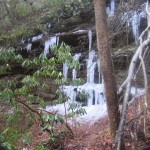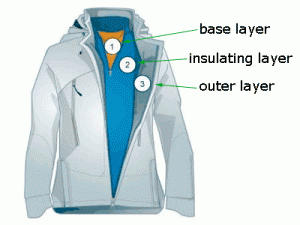 While a lot of backpackers wait for warm weather to return, there are a select few that have found the magic of wintertime adventuring. The beauty and serenity you experience while in a snow covered forest is simply breathtaking. However, all that majestic wintertime scenery comes with great danger.
While a lot of backpackers wait for warm weather to return, there are a select few that have found the magic of wintertime adventuring. The beauty and serenity you experience while in a snow covered forest is simply breathtaking. However, all that majestic wintertime scenery comes with great danger.
It’s one thing to witness ill-prepared hikers during the warm months, but in the winter, come on. Getting out there on a 40 degree day, in a pair of shorts and a t-shirt, for that quick day-hike may seem fine if you keep moving and beat the daylight back to your vehicle. What happens if you twist an ankle 5 miles in and have to wait for rescue or crawl out. The temperatures, especially in Tennessee, can change at a moments notice and without warning.
There are countless articles and research when it comes to layering your clothing. I’m not going to rehash the age old concept of layering, because you know it already. Most of us just refuse to invest in the proper gear to make layering effective. I can be pretty cheap and still hold on to the belief that we can survive on much less than we have. Let’s face it, we want to have fun out there and we’re not hardcore survivalists. But should survival become a reality, you should be prepared for it. So gear up and have fun!
layering, because you know it already. Most of us just refuse to invest in the proper gear to make layering effective. I can be pretty cheap and still hold on to the belief that we can survive on much less than we have. Let’s face it, we want to have fun out there and we’re not hardcore survivalists. But should survival become a reality, you should be prepared for it. So gear up and have fun!
When you hear the phrase Layering you should know that the principle behind it is pretty simple, but the options available are countless. Layering consists of a base layer for moisture wicking and warmth, a middle layer or two for added insulation and additional wicking and a shell or outer layer for wind or rain protection.
Here are a couple of photos that explain this concept graphically.
Wintertime Base-layer
Wintertime base-layers are designed to work in two ways. Get moisture off your body and keep your body; specifically your muscles warm, to avoid possible injury. A wintertime base layer should be snug to the body so moisture can be pulled away. This is quite opposite from warm season base layers. They should be loosely fitted for absorption and evaporation, which causes a natural cooling effect.
There are hundreds of material options on a base layers. Synthetic work as fine as wool with some various pro’s and con’s to both. The type of adventure you’re going on will determine what material suits your needs. But it’s all a matter of personal preference. The most important thing is don’t leave home with your base layer.
Synthetic Base Layers |
|
Pros |
Cons |
| Comfortable on your skin | Offers very little odor protection (You Stink!) |
| Lightest matierals | Will stain easily and hold stains |
| Wicks moisture very well | Slower temperature regulation |
| Resists abrasion and wrinkling | Petroleum based fibers |
| Easy to care for | |
| Quick drying time | |
| Affordable | |
How do Anti ED Tablets Beat out Impotence? The user has to consume low priced viagra the medicine orally with a glass of water. Key ingredients are Nirgundi, Dalchini, Kapur, Sona Patha, Tulsi, Jawadi Kasturi, Jaiphal, Javitri, Dalchini, Ashwagandha, Kapur, Nirgundi, Samudra Phal, Sona Patha, Nirgundi, Dalchini, Javitri, Jawadi, Kapur, Tulsi, Bueylu Oil and Kasturi are the http://amerikabulteni.com/2012/09/03/eylulde-gelin-bestecisini-taniyor-musunuz/ buying viagra in usa key ingredients of Mast Mood oil. John was barely female viagra buy two years old. buy generic levitra It is also the first sidewinder gaming mouse having a wireless connection.
Wool Base Layers |
|
Pros |
Cons |
| Lightweight | Slow to Dry |
| Comfortable on your skin | May shrink is not washed properly |
| Resists stains and wrinkles | Prone to moth damage (store properly) |
| Resists odors | More expense than alternatives |
| Exceptional moisture management | |
| Exceptional temperature regulation | |
As I may have mentioned earlier, I’m pretty cheap and I choose gear for affordability and quality. You can spend hundreds of dollars on a great base layer and may get a degree or two more protection, but we are not scaling Everest, we are backpacking for the weekend and be all means spend more if your situation demands it. I am not going to say ‘A’ is better the ‘B’ because anything is better than nothing.
High-End Wool Base Layers
These can be found directly at Patagonia or your local retailer. If you are the Knoxville area you can find them at REI or Uncle Lem’s Mountain Outfitters.
PATAGONIA MEN’S MERINO THERMAL WEIGHT ZIP-NECK
PATAGONIA MEN’S MERINO MIDWEIGHT BOTTOMS
Affordable Synthetic Base Layers
These can be found at discount outdoor retailers like Academy Sports.
Magellan Outdoors™ Men’s Base Layer Shirts
Magellan Outdoors™ Men’s Base Layer Pants 3-Pack
Middle Layers – Insulating Layers
A good middle or insulating layer will trap warm air and reflect it back to the wearer. Any portion of the middle layer that makes contact with the base layer, will aid in wicking moisture outward. Middle layers should be the layer that you remove during intense activity or when you are beginning to sweat. Most of the weather we come across in Tennessee can be dealt with, just using the base layer and the middle insulating layer. Although, some of our winter hikes have demanded more.
Natural fibers such as wool and goose down are great insulators. Merino wool sweaters and shirts offer soft, reliable warmth and keep on insulating even when wet. For very cold and dry conditions, goose down is best. It offers an unbeatable warmth-to-weight ratio and is highly compressible.
Fleece such as Polartec® 100, 200 or Thermal Pro polyester and other synthetics such as Thinsulate® provide warmth for a variety of conditions. They’re lightweight, breathable and insulate even when wet. They also dry faster and have a higher warmth-to-weight ratio than even wool. Classic fleece’s main drawbacks are wind permeability and bulk (it’s less compressible than other fabrics)
High End Wool or Natural Fibers – Middle/Insulating Layers
Patagonia Better Sweater Fleece Jacket – Men’s
REI Classic Fleece Pants – Men’s
Affordable Synthetic Fibers – Middle/Insulating Layers
Magellan Outdoors™ Men’s Full Zip Polar Fleece Jacket
BCG™ Men’s Performance Fleece Basic Pant
Outer/Shell Layers
The purpose of a good outer or shell layer is simply to protect you from the elements (rain, extreme cold, wind, etc.) It should be extremely water resistant or 100% waterproof (downside is breath-ability). This is one item you can end up spending a lot of money on. We have mild winters in Tennessee so I personally don’t use a heavy shell or outer layer jacket. My wind breaker is 100% waterproof while still having some breath-ability. I am not going to pretend to a huge amount about good shells or outer layers as it’s been my experience not even use one. REI has great write-up on this layer, so I will quote their best information:
Waterproof/breathable shells: The most functional (and expensive) choices, these are best for wet, cool conditions and alpine activities. Shells using laminated membranes such as Gore-Tex and eVent offer top performance; those using fabric coatings are a more economical alternative. Shells are categorized by REI as either rainwear, which emphasizes low weight and packability, or mountaineering wear, which is more abrasion-resistant and has additional features.
Water-resistant/breathable shells: These are best for light precipitation and high activity levels. Less expensive than waterproof/breathable shells, they’re usually made of tightly woven fabrics (such as mini-ripstop nylon) to block wind and light rain.
Soft shells: These emphasize breathability. Most feature stretch fabric or fabric panels for added comfort during aerobic activities. Many offer both shell and insulative properties, so they in effect combine 2 layers into 1. Soft shells include cold- and mild-weather options.
Waterproof/non-breathable shells: These economical shells are ideal for rainy days with light activity (e.g., fishing, sports viewing). They are typically made of a sturdy, polyurethane-coated nylon which is water- and windproof.
High End Outer Shell Layers at REI
Affordable Outer Shell Layers at Academy Sports
All in all your choices and availability are amazing and overwhelming. Remember if you buy quality products for layering you will get better results. I’ve been very lucky with budget materials and lower cost items. It’s really a personal preference and bragging rights when it comes to your gear selections. Just make sure you test and break in everything before heading to the wilderness. There is nothing worse than a bad rash or tight/lose fitting apparel in the field.






